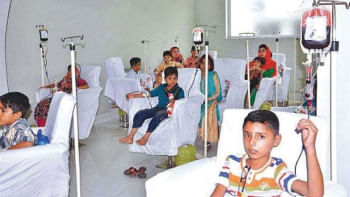How to curb thalassemia in Bangladesh

While Bangladesh has been successful in controlling infectious diseases and reducing child mortality rates over the past decade, its non-communicable disease control (NCDC) programme is yet to effectively take off. Genetic diseases like thalassemia is like the tip of the iceberg, not yet receiving proper attention under the NCDC programme. Few organisations like Bangladesh Thalassemia Samiti, Bangladesh Thalassemia Foundation, and Bangladesh Thalassemia Protirodh Andolon are working on raising awareness and gathering help for the patients within a very limited scope. This year, the theme of International Thalassemia Day was observed on May 8 with the theme "Be Aware. Share. Care: Strengthening Education to Bridge the Thalassemia Care Gap."
Thalassemia is a genetic blood disorder and is one of the most widespread diseases worldwide. There are different types of thalassemia, but in Southeast Asia, Hb-E and Hb-Beta-Thalassemia are the most prevalent. According to the recent data of the World Health Organization (WHO), about 10-12 percent of Bangladesh's population are thalassemia carriers (Hb-E and Hb-Beta-Thalassemia). It is presumed that every year, approximately 6,000-8,000 of the children born in Bangladesh are thalassemic. The number of patients suffering from thalassemia diseases with different levels of severity is estimated to be approximately 70,000-80,000. This high prevalence of thalassemia diseases is due to consanguineous marriage and marriage between two carriers.
Thalassemia carriers are asymptomatic and unaware of the genetic problem. They need no treatment or dietary restrictions, but their importance lies in the prevention of disease by not marrying another carrier. Because when both are carriers, there is a 25 percent probability (one in four live births) of their child being thalassemic, and a 50 percent probability (one in two live births) of the child being a carrier. In the worst case scenario, all their children could be thalassemic.
Many thalassemia patients are transfusion-dependent for life, starting from the age of six months. They are of short stature with facial deformities (thalassemic facies), with delayed or absent puberty. Some variants of thalassemia (like Haemoglobin Bart's hydrops foetalis) are often fatal, but fortunately they are rare in Bangladesh. Thalassemia patients need medical treatment such as regular blood transfusion to keep the haemoglobin up to the target level, screening for blood-borne infections, chelation method to minimise iron overload and endocrine complications related to iron overload, control of osteoporosis and sometimes splenectomy due to hypersplenism.
Hematopoietic stem cell transplantation (HSCT) is the only curative treatment of thalassemia at present. HSCT outcomes (more than 80 percent) are best for younger individuals who have undergone rigorous medical therapy with transfusion and iron chelation to minimise the risk of organ damage from iron toxicities. HSCT for thalassemia was pioneered in the early 1980 and results have continued to improve over time. According to a 2012 analysis, allogeneic HSCT is cost-effective compared to the standard medical treatment.
According to the Thalassemia International Federation (TIF), less than 10 percent of global thalassemia patients in developing countries can access the optimal standard of care. In 2017, it was estimated that the direct cost for treating an individual with transfusion-dependent thalassemia in Italy and Turkey would be approximately $30,000 and $15,000 annually, respectively. In Bangladesh, about $2,500 (around Tk250,000) is spent annually, much less than the developed countries, but it is mostly out-of-pocket expenditure. Thus, the management of thalassemia patients requires a significant use of public health resources (approximately Tk 12,000 crore annually).
Unfortunately, this issue is not being addressed with the appropriate attention in our public health domain. Moreover, many thalassemia patients in the country have not been diagnosed and/or appropriately treated, which clearly indicates a need to improve our community education programme as well as opportunities for genetic and prenatal counselling.
Effective diagnostic and screening programmes are essential for thalassemia prevention. Carrier detection, test for thalassemia before marriage, prenatal diagnosis of thalassemic foetus before 13 weeks of pregnancy, genetic counselling and awareness are utmost important to this end. For thalassemia prevention, Bangladesh can look into Cyprus' experience. In Cyprus, thalassemia was a serious problem, which led to the initiation of strategies for prevention and management of thalassemia in 1976. In 1979, high-risk families started to get screened for thalassemia. In 1980, premarital screening was made compulsory by law. After prenatal diagnosis started in 1984, affected birth rates saw a sharp decrease. Between 1991 and 2001, only five thalassemic babies were born.
There's no doubt that at present, thalassemia is a serious health problem in Bangladesh. The government should formulate a policy for the prevention and treatment of thalassemia immediately. The existing thalassemia patients' standard of care (medical and curative) should be arranged in every public hospital. Planning should be done in such a way that no thalassemia baby can be born in the next five years. The main approach for thalassemia prevention is screening. A policy will have to be in place for the screening of the high-risk group. Premarital screening should be mandated by law as well. Scope for prenatal diagnosis should be increased in all medical college hospitals.
Prof Dr MA Khan is adviser to the Thalassaemia Samity Hospital and former head and founder of the Department of Haematology and Bone Marrow Transplant Unit at Dhaka Medical College Hospital (DMCH).


 For all latest news, follow The Daily Star's Google News channel.
For all latest news, follow The Daily Star's Google News channel. 








Comments